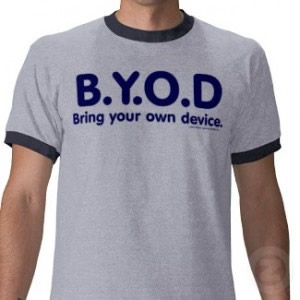Bring Your Own Device Issues:
Alcatel-Lucent and AirTight Networks are offering designs that address the ever growing trend that is bring-your-own-device (BYOD) which is putting more and more pressure on networks.

With the recent boom in popularity of smartphones and more recently the tablet PC, employees and C-level executives are expecting to be able to access the company networks on their devices.
Cause and Effect
Despite the increase in employee productivity the BYOD trend has brought with it, it has been cause IT administrators a great number of headaches as they are having to look back at all of the security measures in place and the bandwidth which these devices will require.
The IT administrators now have to find a way of keeping the networks secure whilst granting employee’s access via the mobile devices and controlling the effect this will have on the speeds of the network. Networking companies are developing systems designed to aid IT administrators manage mobile device access, one of which is Extreme Networks and their Intelligent Mobile Edge product.
Alcatel-Lucent’s take on BYOD
Alcatel-Lucent is adding to the market with its offering of its Converged Network Solution. The application allows the networks to track what device is connected to the network and who is using the device, plus the applications that are being used. The application has been designed to identify which applications require a higher quality of connection than other dependent on business criticality.
“Our solution helps enterprises keep their employees satisfied and productive, while reducing the capacity-sapping impact of personal services and devices on their networks,”
Stephane Robineau, vice president and general manager of Alcatel-Lucent Enterprise Network Business, said in a statement.
“As importantly, by building application fluency capabilities into the network, we are also making it possible for enterprises to ensure that employees who need guaranteed service quality for bandwidth-heavy applications, like video conferencing, can get it when they need it.”
Whilst the application allows the management of mobile devices on the network it also makes the use of external services such as cloud computing much easier.
Part of Alcatel-Lucents solution is the OmniSwitch 6450 Ethernet LAN switch, a 1GbE device that offers network access and can include 10GbE uplinks. This device will be made available between April and the end of June.
AirTight’s take on BYOD
AirTight has introduced a device “fingerprinting” capability into its Spectragaurd Enterprise Wireless Prevention Services (WIPS) and AirTight Cloud Services. The new fingerprinting capability was designed to enable easy identification for mobile devices on a network and check that they meet with the requirements of corporate policies.
“AirTight uses correlation of information from over-the-air and on-the-wire packets,” Parekh said in a statement. “This method produces accurate information about all smart devices (including iPhones, iPads, Androids and BlackBerrys) connected to the network to enable automatic classification and policy enforcement of ‘approved’ versus ‘unapproved’ devices.”
Along with the device fingerprinting AirTight also have a workflow designed to simplify BYOD management (patent-pending), mobile device quarantine, hotspot authorisation, Wi-Fi device pinpointing on premise, BYOD management API that integrates with mobile device management (MDM) systems and produces BYOD reports that can be emailed to any inbox required.
As the BYOD trend gains more momentum the pressure put on IT departments is increasing as is the number of businesses that are adapting their IT systems to accommodate this is up to 60 percent, according to a report from Avande. Nearly 90 percent of business leaders understand that employees use personal devices for work, 65 percent of C-level executives have acknowledged that BYOD is a high priority for their companies.
“Despite the notion that business leaders are resisting the shift, we found that companies are investing in staff and resources to enable the consumerisation of IT and have many of the resources that are needed today,” said Tyson Hartman (Avanade CTO) when they released the report.
It would seem that the BYOD trend will continue to bring new innovations and issues as things progress.
James Hedges